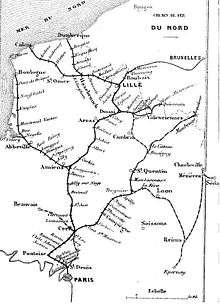Chemins de Fer du Nord
The Chemins de Fer du Nord[1][2][3][4][5] (French: Compagnie des chemins de fer du Nord or CF du Nord), (English: Northern Railway Company) often referred to simply as the Nord company, was a rail transport company created in September 1845, in Paris, France. It was owned by among others de Rothschild Frères of France, N M Rothschild & Sons of London, England, Hottinger, Laffitte and Blount.[6] Baron James de Rothschild served as the company's first president from its inception until his death in 1868.
History
A royal ordnance dated 10 September 1845 granted exploitation of the railway from Paris to Lille and Valenciennes, branch lines to Dunkirk and Calais and two new lines Creil - Saint-Quentin and Fampoux - Hazebrouck to the CF du Nord. From the Gare du Nord station the company built in Paris, the Paris–Lille railway line led north towards Belgium, first connecting in 1846 to Amiens, Douai and Lille, with a branch line from Douai to Valenciennes.[6] Lille and Valenciennes had already been connected to the Belgian railway network in 1842.[7] The new line made it possible to travel by train from Paris to Brussels and further.
In the following years, the network was rapidly expanded:[7]

| Railway line | Opened |
|---|---|
| Paris–Lille railway | 1846–1859 |
| Douai–Valenciennes railway | 1846 |
| Longueau–Boulogne railway | 1847–1848 |
| Creil–Jeumont railway | 1847–1855 |
| Lille–Fontinettes railway | 1848–1849 |
| Arras–Dunkirk railway | 1848–1862 |
| Amiens–Laon railway | 1857–1867 |
| Creil–Beauvais railway | 1857 |
| Hautmont–Mons railway | 1858 |
| Chemin de Fer de la Somme | 1858 |
| Busigny–Somain railway | 1858 |
| Paris–Hirson railway | 1860–1871 |
| Lens–Ostricourt railway | 1860 |
| Chantilly–Crépy-en-Valois railway | 1862–1870 |
| Lille–Tournai railway | 1865 |
| Boulogne–Calais railway | 1867 |
| Rouen–Amiens railway | 1867 |
Competition
The potential for expansion of the CF du Nord territory was limited by other companies: the Chemins de fer de l'Ouest to its southwest, and the Chemins de fer de l'Est to its east. By opening a line from Paris to Hirson via Soissons and Laon from 1860 to 1871, it protected its eastern border against CF de l'Est expansion. The concession for the line from Creil to Beauvais, owned by CF de l'Est predecessor Chemins de fer des Ardennes, was exchanged for the Nord's concession for Laon–Reims in 1855.[6]
In 1937 the CF du Nord was nationalised, as were the other main railway companies, to become part of the Société nationale des chemins de fer français (SNCF).
Activity
In 1926 started regular connection of the luxury passenger train from London to Paris, Golden Arrow/Fleche d'Or with British Southern Railway. For transport of passengers' baggage four containers were used. These containers were loaded in London or Paris and carried to ports, Dover or Calais, on flat cars in the UK and “CIWL Pullman Golden Arrow Fourgon of CIWL” in France.[8]
In the arts
In 1855 Baron Rothschild commissioned photographer Edouard Baldus to do a series of photographs of the various landmarks on the railway line between Boulogne-sur-Mer and Paris. The photographs were used to create an album for Queen Victoria and Prince Albert as a souvenir of their visit to France that year. The album can be seen today in the photographic collection in the Royal Archives at Windsor Castle.
Locomotives of the Nord
References
- Bulletin of the International Railway Congress Association, Vol. 26, p. 39 (1912).
- Hollingsworth, Brian (2000). The Illustrated Directory of Trains of the World, p. 49, Salamander Books, MBI, Osceola. ISBN 0-7603-0891-8.
- The Railway Age, Vol. 39, p. 688, Wilson Company. (1905).
- The Railroads Of France at www.fee.org. Retrieved on 28 Jul 2013
- French locomotive built in 1846 at National Railway Museum website. Retrieved on 28 Jul 2013
- Joanne, Adolphe (1859). Atlas historique et statistique des chemins de fer français (in French). Paris: L. Hachette. pp. 21–22.
- Direction Générale des Ponts et Chaussées et des Chemins de Fer (1869). Statistique centrale des chemins de fer. Chemins de fer français. Situation au 31 décembre 1869 (in French). Paris: Ministère des Travaux Publics. pp. 146–160.
- Lewandowski, Krzysztof (2014). "Czechoslovak activity to prepare European norms for containers before the Second World War" (PDF). Acta Logistica. 1 (4): 1–7. ISSN 1339-5629.
External links
| Wikimedia Commons has media related to Compagnie des chemins de fer du Nord. |